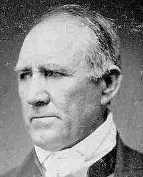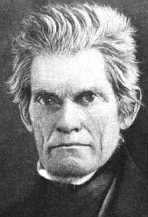On August 3 and 4, 1850 a letter appeared in various newspapers throughout the United States detailing a sinister plot supposedly hatched by Southern conspirators to leave the Union and confederate with Mexico. According to the correspondent, who used three different pen-names ('Independent,' 'Veritas,' and 'Viator'), an influential Southern gentleman highly placed in the American government had travelled incognito to Mexico earlier that year in April. This gentleman had then contacted Mexican officials to whom he had proposed a plan whereby the South would leave the Union and join together with Mexico. The capital of the proposed new nation was to be Mexico City.
Supposedly the Mexican foreign minister had welcomed the offer, and the British charge d'affaires in Mexico City had also encouraged it. However, the Mexican cabinet had rejected the offer. Thereupon, the Southern emissary had departed from Mexico and travelled to California.
The correspondent concluded his letter by demanding that Congress investigate this treasonous affair.
A second letter from this same correspondent appeared in papers four days later explaining that he knew about the plot because he had been shown incriminating diplomatic papers by a government official. However, he had been forbidden to reveal who had informed the government of the plot.

Senator Sam Houston
On August 6 a letter from a second correspondent, who called himself 'Henrico,' appeared in the
Philadelphia Evening Bulletin further elaborating on the plot. According to Henrico, details of the plot had been shown to Senator Sam Houston the previous winter, and Houston had been promised the presidency or dictatorship of the new confederation if he agreed to it. In addition, the conspirators were apparently planning to coerce Mexico into accepting their agreement by threatening to incite revolts in its frontier provinces unless it agreed. However, even with this threat, Mexican officials had still rejected the offer. They had realized that uniting with the South would not only mean the spread of slavery throughout Mexico, it would also mean running the risk of being absorbed into the U.S. if the North later declared war on the South.
A few days later a third correspondent, who called himself 'Scrutator,' began submitting a series of letters about the issue to the
Philadelphia Inquirer. Scrutator claimed that John Calhoun, the famous South Carolina firebrand who had once been Andrew Jackson's vice-President, had originally conceived the plan. Calhoun, however, had recently died, thus leaving the enactment of his plan to others. Scrutator then demanded that Houston reveal the contents of the treasonable papers he had seen.

John C. Calhoun
On August 15 the issue came to a head when portions of Scrutator's letter were read in the U.S. Senate, and Houston was challenged to reveal whatever he knew about the issue. Houston denied having any knowledge of such a plot.
A new letter from Scrutator appeared a few days later saying that he had visited Houston following the confrontation in the Senate, and that Houston had privately admitted that he had heard details of a vaguely similar plot a long time ago. However, the plot had never been anything more than a wild speculation. Nevertheless, Scrutator suspected that Houston was hiding something and demanded that he reveal the whole scheme. Scrutator continued to pen more letters demanding that Houston reveal whatever he knew, but Houston never cooperated and publicly denied any knowledge of such a plot.
Meanwhile public opinion in the North was split about whether there really was a Southern plot to confederate with Mexico. A correspondent for the
Pittsburgh Gazette wrote a letter in which he claimed to know who the treasonous Southern emissary was supposed to have been. The emissary was supposedly Robert Greenhow, a State Department employee and a close friend of Calhoun. Greenhow and his wife Rose O'Neal were well-known figures in Washington social circles, and Greenhow had actually been in Mexico in April. He had been sent there to gather information from Mexican archives about California land claims which had become extremely confused during the recent gold rush. However, the correspondent for the
Pittsburgh Gazette ridiculed the idea that Greenhow had participated in any plot.
Southern papers, of course, dismissed the idea of such a plot out of hand, and when no more news about the conspiracy surfaced, public interest in the affair gradually waned in both the North and South.
Did the South offer to confederate with Mexico in 1850, or was the entire story a hoax? The historian Mark Stegmaier recently investigated the issue and determined that it was a hoax.
Stegmaier found that Greenhow had been in Mexico until late October, 1850, at which point he had gone to California where he established a law practice in San Francisco. Greenhow died in 1854, but during the Civil War his wife, Rose O'Neal, became a famous Confederate spy. This indicates that Greenhow would certainly have had the connections and the opportunity to commit such a plot. However, Stegmaier points out that there was nothing surreptitious about Greenhow's trip to Mexico. It was fully sanctioned by the State Department.
More importantly, no mention of such a plot appears in either U.S. nor Mexican diplomatic records from the period. Given that the plot involved such high-level treason, if anything had occurred it would almost certainly have been mentioned somewhere in these records.
Stegmaier theorizes that some American official forged incriminating evidence which he then showed to political correspondents in Washington, who unquestioningly accepted the evidence as real, being eager for a sensational story.
Stegmaier points out that the news of the plot appeared in papers days after the defeat in Congress of the Omnibus Bill. The Omnibus Bill was an attempt to reach a compromise between the Northern and Southern states whereby the contentious issue of the expansion of slavery into the Western territories could be peaceably resolved. Radicals in both the North and the South were glad that the bill had been defeated, but moderates had been horrified because they feared the approach of sectional conflict.
It is likely that one of these moderates invented the story of the plot, and then leaked it to reporters as a way to scare the public about the possibility of disunion, and thus gain support for the effort to get the pieces of the Omnibus bill approved individually.
Of course, Southern radicals definitely were dreaming of such treasonous schemes by 1850, but their schemes, at that point, largely existed only on paper. It appears highly doubtful any high-placed Southern government official, let alone Robert Greenhow, actually approached Mexican authorities to make a deal. Stegmaier concludes that the rumor of such a plot was simply "a manifestation of rampant public paranoia during the crisis of 1850."
Links and References
- Stegmaier, Mark J. "Treachery Or Hoax? The Rumored Southern Conspiracy To Confederate With Mexico". Civil War History 1989 35(1): 28-38.



Comments